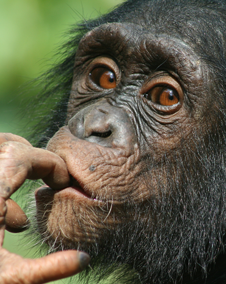
Our boat lands on the sandy shores of Gombe Stream National Park where 26 year old Jane Goodall and her mother Vanne first arrived in July, 1960.
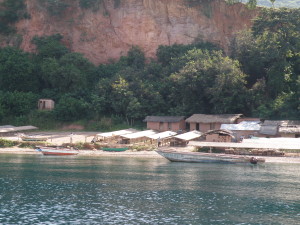
Soon afterwards Dr. Jane’s ground breaking behavioral research on chimpanzees (under the direction of Dr. Louis Leakey), aided by her patience, tenacity, and love for animals catapulted her to the most admired and recognizable face of conservation.
If you’re a fan of Jane Goodall (and who isn’t) you’ve probably wondered what it would have been like to wander the forest of Gombe in search of the chimpanzees, just like Jane did. You may even have hopes of visiting Gombe, Tanzania’s smallest park, someday.
During my work as the Africa Adventure Specialist for the Jane Goodall Institute I was in charge of designing and leading safaris for members of her organization, and my safari itineraries always included a trip to Gombe to see the world’s most famous chimpanzees.
None of us can be in Jane’s shoes, to feel what she felt as a young woman walking through Gombe’s now 30 square miles of forest, living in a tent on the eastern shore of Lake Tanganyika. But every time I visit Gombe I try. And now you can too.
Keep reading for a glimpse of what it takes to hike in Gombe to see the chimps.
~~~~~
The World of Gombe’s Chimps
A deafening scream engulfs the jungle, spurring a troop of colobus monkeys into action. Away from the danger they fly like trapeze artists through the treetops above us.
“The chimps are very close,” Emmiti, our trekking guide, tells the cadre of eight excited tourists on this safari.
For almost an hour we have been following Emmiti along forest trails worn clear by the comings and goings of bushbuck, bush pigs, chimps and baboons. He points out broken blossoms and small yellow fruits “related to nutmeg” with large black seeds coated in red – “scraps from the chimps feasting in the evergreen canopy above us.”
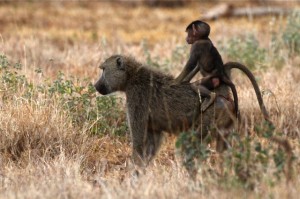
We hear the chimps but can’t see them
We hear a scream, followed by rustling branches as the chimpanzees advance upslope ahead of us, out of view.
The ape’s occasional ear-splitting yells serve as beacons to locate them. Through a walky-talky Emmiti stays in constant communication with researchers who enter the forest at dawn searching for leaf-laden beds the chimps have made and slept in the previous night. Once the chimps are found, the researchers follow (and record) the animal’s movements the rest of the day, continuing Dr. Jane’s initial research, and making this the longest consecutive study done on any wild animal in the world.
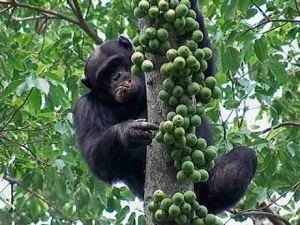
“They’re moving fast but we are near,” Emmitti’s says, and quickens our pace forward. We reach an area now named Jane’s Peak, the high plateau from which young Jane, using an old pair of hand me down binoculars, scanned the forest each day looking for her research subjects.
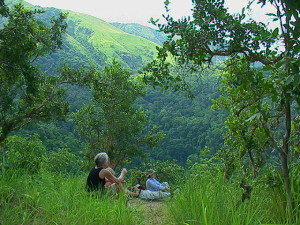
“The park has more than 200 bird species, and 11 species of snakes,” Emmiti says, stopping near a trickling stream edged by ferns. By now we’ve been hiking for 1½ hours. A couple of us lean wearily against the soft body of a gigantic fig tree with rounded leaves the size of frisbees. “There are also leopards here,” he says proudly, “but I’ve never seen one.”
Determined to intersect the apes, Emmiti leads us off the trail, onto a steep incline. For thirty minutes we bush whack upwards through a dense tangled world of vines and thin-branched shrubs. With each step we test the ground, searching for dirt that won’t give way underfoot, and unwrap hostile vines from our arms and legs.
“They are moving fast but we are close now,” Emmiti says as he passes by me on the side of the hill, spread eagle, holding onto a thin twig sticking out of the ground.
I look over at our intrepid group, also leaning against the hill, shirts stained dark, beads of sweat dripping down their faces.
“I don’t think we can go on like this for much longer,” I whisper to Emmiti so the others don’t hear. “We need to stop.”
“Does anyone want to turn back?” I ask.
Water bottles held to their mouths, everyone shakes their head, No.
“OK. Let’s just rest here for a few more minutes.”
Everyone shakes their head, Yes.
The chirps of unseen birds join the whirr and buzz of cicadas and other insects, but the chimps have gone silent.
Time-lapsed Discovery Channel images enter my mind.
Humid, dense riverine forests like these are masters of conversion. Everything the forest produces – fallen leaves, animal bones, butterfly wings, and anything that stops moving long enough, will be transformed to rich compost. I envision army ants devouring my flesh, one small chunk at a time, and strangler vines, covering their ‘prey’ in a cocoon, converting it back to the earth.
How long would we have to stay here before the conversion back to the earth begins, I wonder?
Emmiti interrupts my reverie. “Everyone ready,” he says more as a statement than a question. I think I detect frustration in his voice. Has our need to rest sealed our fate? Have the chimps moved too far away now?
I unwrap the mottled green vine that has taken my left leg as hostage, swat a mosquito on my cheek, and move up the hill behind Emmiti.
Five minutes into our steady upward pace Emmiti announces for the fourth time today, “We are very near.”
Susan gives me a look, really?
I wonder what Emmiti’s definition of ‘very close’ is. We haven’t heard the chimps for the past twenty minutes and I’ve mentally prepared myself for failure. This will be the first time in the eight years I’ve organized tourist trips to Gombe that our group won’t see the infamous primates.
Emmiti slows his fervent pace, stopping along a flat trail on a ridge near the top of the hill. He turns toward us, his forefinger placed over his mouth. “Shush”, each of us commands the person behind as we cluster together.
I’m dubious. Then I sense something. The forest is alive with subdued movement. Through the dappled shadows I see them. Twenty-four chimpanzees, the largest troop I’ve ever witnessed, surround us.
“They’ve taken a break from feeding, and we’re in their resting area,” Emmiti says. “We’re lucky.”
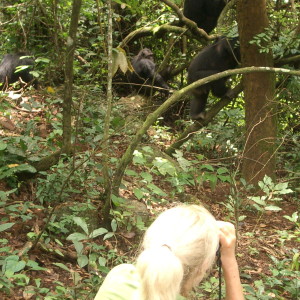
We each sit on a tree stump or patch of ground void of army ants. Black-furred bodies climb tree trunks, hanging from branches with one hand, eyeballing our group. Passing us on all fours a group of five chimps are so near I could touch them. I think of Jane Goodall when she first made contact with David Greybeard, one of her most memorable moments. She reached out her hand to him in an unprecedented gesture, and he responded in turn.
I want to hold hands with a chimp I thought. But it’s too dangerous. We share 98% of our DNA with these great apes, our closest living relatives, making disease easily spreadable between our two species. Touching them can kill them. Tourists have to have a series of vaccinations when signing up for this adventure, and are told to suppress any coughing or sneezing while in the presence of the wild chimps.
A few chimpanzees start yelling like a gaggle of children on a playground. Through my binoculars I see the source of their excitement – a six-inch thick gray python curled in the grass. The chimps scream with protest and warning while pelting their target with sticks and rocks.
Sitting on a log near me, a young whimpering male displays himself. “He can’t find his mother in all the confusion,” one of the researchers tells us, “he’s feeling insecure.”
After the commotion dies down, tiny baby apes swing precariously around older females (mothers?) resting in wide tree-notches. Adolescents chase each other around their human visitors. They are used to being watched.
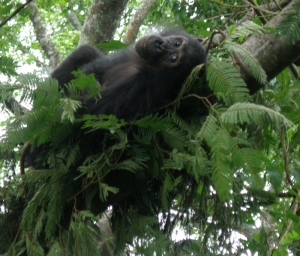
I lay down on the leafy ground mimicking a chimp twenty feet from me. Our eyes meet and I imagine living full time in his world. I try to imagine Dr. Jane living here with little comforts or human companionship, day after day searching for the chimps, just like we have done today.
I’m full of admiration and envy.
7 Replies to “Greeting Jane Goodall’s Chimpanzees of Gombe”
Comments are closed.

She is my hero and I have dreamed of going to Gombe but doubt I will so thanks for sharing the experience. I got a “glimpse” of the place.
Enjoyed reading this Jane Goodall Gombe piece you wrote. I like how you describe and also convey the emotion.
Your account was almost like being there.
Oh great Rochelle. I was hoping that was the case because I know most people will never get there.
I adore n admire Dr Jane Goodhall. It was such a pleasure to have met her on two occasions. Will love to go to Gombe someday.??????
Wow nice Sharing that experience, it proves patience pays
I love Jane Goodall, and I think she’s plain amazing. I am in Roots and Shoots, her group. It was amazing to meet her in the Roots and Shoots awards ceremony a few weeks ago!